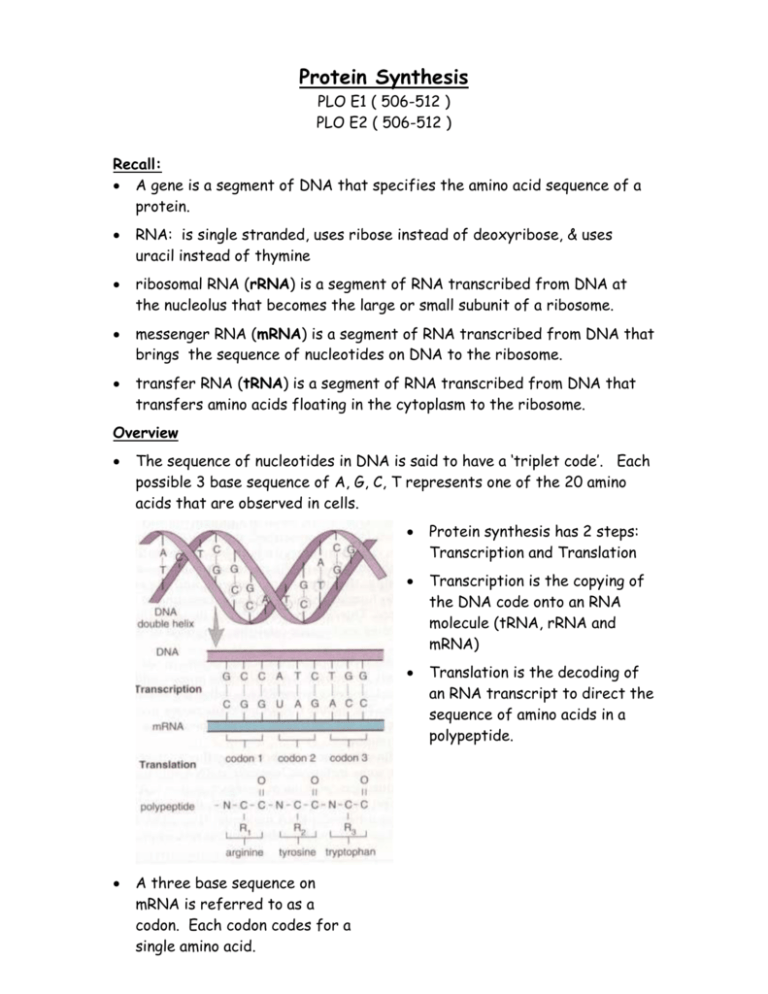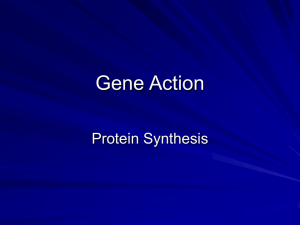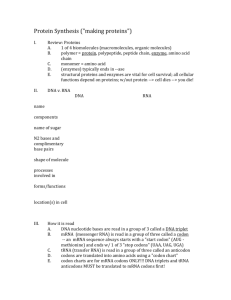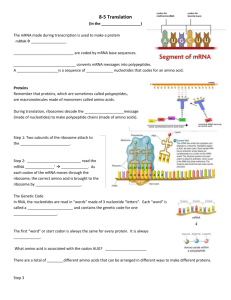Protein Synthesis
advertisement

Protein Synthesis PLO E1 ( 506-512 ) PLO E2 ( 506-512 ) Recall: A gene is a segment of DNA that specifies the amino acid sequence of a protein. RNA: is single stranded, uses ribose instead of deoxyribose, & uses uracil instead of thymine ribosomal RNA (rRNA) is a segment of RNA transcribed from DNA at the nucleolus that becomes the large or small subunit of a ribosome. messenger RNA (mRNA) is a segment of RNA transcribed from DNA that brings the sequence of nucleotides on DNA to the ribosome. transfer RNA (tRNA) is a segment of RNA transcribed from DNA that transfers amino acids floating in the cytoplasm to the ribosome. Overview The sequence of nucleotides in DNA is said to have a ‘triplet code’. Each possible 3 base sequence of A, G, C, T represents one of the 20 amino acids that are observed in cells. A three base sequence on mRNA is referred to as a codon. Each codon codes for a single amino acid. Protein synthesis has 2 steps: Transcription and Translation Transcription is the copying of the DNA code onto an RNA molecule (tRNA, rRNA and mRNA) Translation is the decoding of an RNA transcript to direct the sequence of amino acids in a polypeptide. There are 64 possible codons considering there are 4 bases. (see figure 25.6 on page 507). Sixty-one of those represent an amino acid, three are stop codons. Since there are more codons than amino acids, some of the amino acids have more than one codon. Transcription (making a close copy) DNA helix unwinds near gene to be used. Complementary pairing occurs with RNA nucleotides on one strand of unzipped DNA. RNA polymerase joins the nucleotides to make a single stranded RNA molecule. The code is transcribed. Uracil instead of thymine. A mRNA polymer transcribed now has codons that are complementary to that of the DNA ‘triplet code’. The mRNA passes out of the nucleus and into the cytoplasm to undergo TRANSLATION. Translation (Decoding the nucleotide sequence) There are many tRNA molecules that bring amino acids to ribosomes. These single strands of RNA are boot-shaped and have two important regions. On one region there is an anti-codon. A triplet code of nucleotides that is complementary to a specific codon of mRNA. On another region there is an amino acid binding site that is very specific for which amino acid it picks up. The specificity of this site is related somehow to the anti-codon but the mechanism of this is unclear. ribosomes are made of two RNA subunits at the nucleolus. These two ribosomal subunits each combine with proteins in the nucleus but do not come together until they are in the cytoplasm to make a ribosome. Every ribosome has a binding site for a single mRNA molecule and two tRNA molecules. This is where codon and anti-codon meet. The ribosome moves along the mRNA and displays the codons for tRNA to match up with. The amino acids that are attached to the tRNA’s undergo condensation synthesis to form a polypeptide. There may be more than one ribosome on a mRNA molecule at one time. This complex is referred to as a polyribosome. Once a single ribosome has read the entire mRNA molecule, the two subunits break away from the mRNA and from the newly formed polypeptide (protein). Translation Details There are three main steps: 1. Chain initiaition: a small ribosomal subunit binds to a mRNA molecule near the start codon (AUG). This is followed by binding of an initiator tRNA molecule whose anti-codon is complementary to the start codon (UAC). Lastly, a large ribosomal subunit joins the complex. 2. Chain Elongation: The second codon on the mRNA molecule is then met by the respective anti-codon on a tRNA carrying it’s amino acid. Both tRNA’s occupy separate binding sites on the ribosome. The initiator tRNA then leaves and it’s amino acid is left stuck to the amino acid of the second tRNA. The ribosome then shifts down 3 nucleotides to display the next codon and awaits the next tRNA with the complementary anticodon. This continues until a stop codon is reached and termination begins. 3. Termination: When a stop codon is displayed in the ribosome, there is no tRNA with the complementary anti-codon to bring an amino acid. A release factor cleaves the last amino acid from it’s tRNA and the completed polypeptide, the last tRNA, the mRNA and the two ribosomal subunits dissociate from each other. If the ribosome was floating free in the cytoplasm, then the protein will simply fold (tertiary structure) or may become associated with other proteins (quaternary structure). If the ribosome was on the rough ER then the protein may get clipped or chemically altered and prepared for secretion or insertion into the plasma membrane. Notes: A change in the sequence of nucleotides in the DNA (a mutation) can cause a difference in the sequence of amino acids of it’s corresponding polypeptide. Since proteins through their various functions determine our traits, it is clear that a mutation can alter the traits expressed by a cell. Protein synthesis is the connection between genotype and phenotype. mRNA codon chart Protein Synthesis PLO E3 ( 516 ) PLO E4 ( 475, 476 ) Types of Mutations Chromosomal Point Insertions Deletions Substitutions Translocation Transverse Frameshift Transposons Mutagens radiation (radioactive elements, X-rays, ultraviolet radiation) cause all types of mutations. organic chemicals (benzopyrene from cigarettes, nitrosamines from cured meats) Some mutagens cause changes in DNA sequence by clipping or rearranging the nucleotides. Others like bromouracil mimic bases in DNA. If bromouracil is inserted into DNA instead of thymine and it is in a special form, it will pair with guanine instead of adenine. Other mutagens chemically alter the bases that are in DNA; for example, nitrous acid changes adenine to hypoxanthine which can base pair with C rather than T Tay-Sachs Disease This disorder is characterized by: slow development between 4 and 8 months of age neurological impairment and psychomotor difficulties become apparent blindness, helplessness, uncontrollable seizures, & eventually paralysis death by age of 3 or 4 The disease is caused by inheritance of two mutated forms of the gene that codes for hexosaminidase A (Hex A). This enzyme usually degrades a glycosphingolipid. The mutated gene produces an enzyme that has about half the activity of Hex A; therefore it’s substrate, a glycosphingolipid builds up in lysosomes (especially in brain cells which explains the symptoms) An individual with the disorder is homozygous for the malfunctioned enzyme meaning the mutated form was carried by both parents. Pre-natal diagnosis: amniocentesis or chorionic villus sampling. Cystic Fibrosis 1 in 20 is a carrier 1 in 3000 have the disorder This disorder is characterized by: Thick mucus in bronchial tubes and pancreatic duct salty skin persistent coughing, wheezing excessive appetite yet poor weight gain frequent infection of the lungs poor flow of pancreatic enzymes to the small intestine With treatment, life expectancy has been increased to about 35. The disease is caused by a mutation of a gene that codes for a membrane channel protein for chloride ions. To have the disease, the individual must have a defective gene from both parents for the chlorine pumping membrane protein. Phenylketonuria (PKU) This disorder is characterized by: Poor nervous system development mental retardation if diet not altered phenylketone in the urine This disease is caused by a lack of the enzyme that normally metabolizes the amino acid phenylalanine. An abnormal breakdown product, a phenylketone, therefore accumulates in the urine. Treated by lowering phenylalanine intake. Two copies of the defective gene must be inherited that usually codes for the enzyme. Neurofibromatosis (Recklinghausen) This disorder is characterized by: large tan spots on skin at birth benign tumors develop some have skeletal deformities like large head, eye/ear tumors that cause blindness/deafness learning disabilities hyperactivity A protein called neurofibromin normally blocks growth signals leading to cell division Affected individuals have a mutated form of the gene on chromosome 17 that codes for neurofibromin. Cell growth signals are not blocked and there is excessive cell division (ie. tumors) Huntington Disease This disorder is characterized by: degeneration of brain cells severe muscle spasms personality disorders death approximately 15 years after first signs (usually during teens) The disorder is caused by a single copy of a mutated gene for the protein huntingtin. This proteins purpose is unclear yet it’s necessary for proper nerve cell function. The mutation causes huntingtin to have too many copies of the amino acid glutamine. Normal huntingtin has between 10 and 25 glutamines whereas the mutated gene produces huntingtin with 36 glutamines. This changes the shape of the protein and it forms clumps in neurons and causes other proteins to clump as well.








